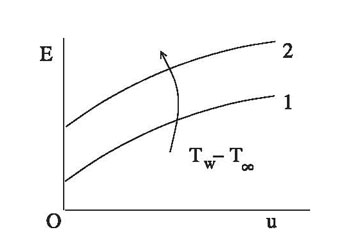| |
The wire  is maintained at a constant temperature higher than that of the ambient, by passing a current through it. The flow past the probe cools it and momentarily reduces its temperature. The change in temperature results in a change in resistance of the wire is maintained at a constant temperature higher than that of the ambient, by passing a current through it. The flow past the probe cools it and momentarily reduces its temperature. The change in temperature results in a change in resistance of the wire  . This is sensed by a feedback control circuit which passes more current through the wire to restore it to its original resistance and temperature. The excess voltage . This is sensed by a feedback control circuit which passes more current through the wire to restore it to its original resistance and temperature. The excess voltage  required to maintain the wire temperature constant, when exposed to a flow, is a measure of the flow velocity required to maintain the wire temperature constant, when exposed to a flow, is a measure of the flow velocity  itself. This unique relationship between itself. This unique relationship between  and and  must be obtained by calibration, i.e. must be obtained by calibration, i.e.  must be determined in a controlled experiment where must be determined in a controlled experiment where  is precisely known. Typical calibration curves for hot-wire are shown in Figure 2.11 in which is precisely known. Typical calibration curves for hot-wire are shown in Figure 2.11 in which  and and  denote the wire temperature and the local fluid temperature respectively. In a calibration experiment, it is common to keep denote the wire temperature and the local fluid temperature respectively. In a calibration experiment, it is common to keep  and and  individually constant to generate each of the curves individually constant to generate each of the curves 

Figure 2.11: Calibration Curve of a Hot-wire Probe. |
|